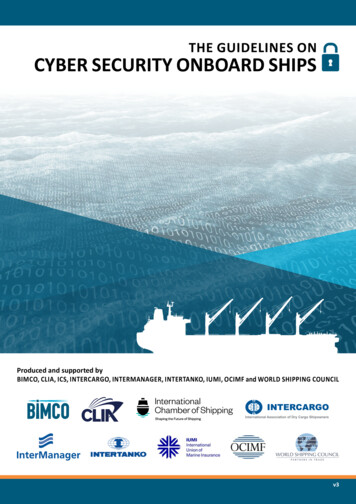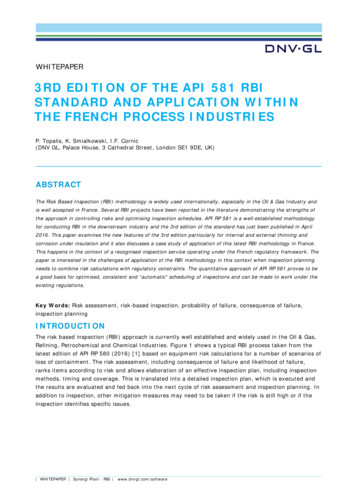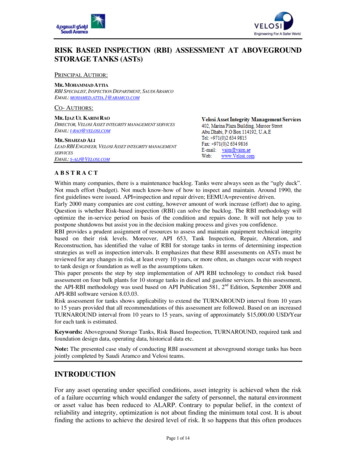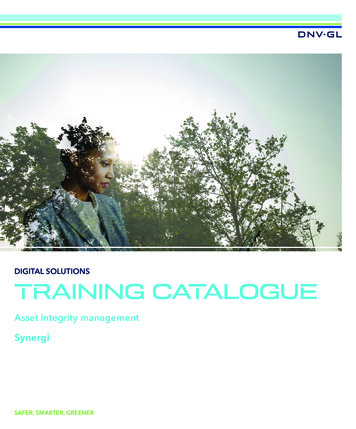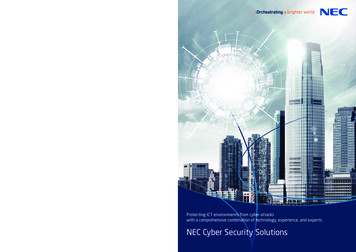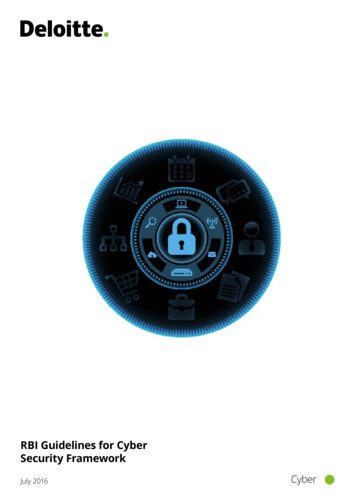
Transcription
RBI Guidelines for CyberSecurity FrameworkJuly 2016
RBISocialGuidelinesImpact for Cyber Security FrameworkRBI Guidelines for Cyber Security FrameworkDifference betweenCyber Security andInformation SecuritySettingthe contextWhile Information Security focuses on protecting confidentiality, integrity, and availability ofinformation, Cyber Security is the ability to protect or defend the use of cyberspace from cyberattacks. Cyberspace is nothing but interconnected network of information systems or infrastructuressuch as Internet, telecommunications networks, computer systems, embedded processors andcontrollers and many others systems.Traditional information security has limited coverage of risks emanating from cyberspace such asCyber warfare, negative social impacts of interaction of people (trolling, defamatory viral messages,etc.), software and services on the Internet and threats from Internet of Things (IoT). These and otherthreats are not classic information security issues and thus need to be covered under a separate CyberSecurity Framework. The emerging technologies and tools within the cyberspace is rapidly increasingorganizations exposure to new vulnerabilities thereby increasing the risk to the organization. Given thebenefits of the cyberspace, it is imperative that organizations manage their risk effectively through arobust Cyber Security Framework.In a race to adopt technology innovations, Banks have increased their exposure to cyber incidents/attacks thereby underlining the urgent need to put in place a robust cyber security and resilienceframework.The Reserve Bank of India has provided guidelines on Cyber Security Framework vide circular DBS.CO/CSITE/BC.11/33.01.001/2015-16 dated June 2, 2016, where it has highlighted the urgent needto put in place a robust cyber security/resilience framework to ensure adequate cyber-securitypreparedness among banks on a continuous basis.The RBI Guidelines related to Cyber Security framework will enable banks to formalize and adoptcyber security policy and cyber crisis management plan. The requirement to share informationon cyber security incidents with RBI will also help structure proactive threat identification andmitigation.Did you know?Financial services companies are most vulnerable to cyber attacks The financial services industry topped the list of 26 different industries that cyber criminalsmost targeted.8 Financial services remains the industry most susceptible to malicious email traffickers,as consumers are seven times more likely to be the victim of an attack originating from aspoofed email with a bank brand versus one from any other industry.90203
RBI Guidelines for Cyber Security FrameworkRBI Guidelines for Cyber Security FrameworkStructure of RBIGuidelines on Cyber Security FrameworkRBI Guidelines on Cyber Security framework focus on the following three areas:01. Cyber Security and Resilience02. Cyber Security Operations Centre (C-SOC)03. Cyber Security Incident Reporting (CSIR)The Cyber Security Framework for bank widely covers the follows domains:Cyber Security FrameworkCyber Security PolicyCyber Security StrategyRisk / Gap AssessmentIT ArchitectureNetwork and DatabaseSecurityCyber Security PolicyCyber Crisis ManagementPlanCyber Security PreparednessIndicatorsOrganization StructureCyber SecurityAwarenessContinuous SurveillanceAnnex 2 – CyberSecurity OperationCentre (C-SOC)Reporting CyberIncidentsAnnex 3 – CyberSecurity IncidentReporting (CSIR)Annex 1 – Baseline Cyber Security and Resilience RequirementsDetailed Requirements of Cyber Security FrameworkThe detailed requirements for each of the Annexures of Cyber Security Framework are as follows:Annex 1 – Baseline Cyber Security and Resilience RequirementsInventory Management ofBusiness IT AssetsPreventing execution ofunauthorized softwareEnvironmental ControlsNetwork Management andSecuritySecure ConfigurationApplication Security LifeCycle (ASLC)Patch/Vulnerability &Change ManagementUser Access Control /ManagementAuthentication Frameworkfor CustomersSecure mail and messagingsystemsVendor Risk ManagementRemovable MediaAdvanced Real-time ThreatDefense and ManagementAnti-PhishingData Leak preventionstrategyMaintenance, Monitoring,and Analysis of Audit LogsAudit Log settingsVulnerability assessmentand Penetration Test andRed Team ExercisesIncident Response &ManagementRisk based transactionmonitoringMetricsForensicsUser / Employee/Management AwarenessCustomer Education andAwarenessAnnex 2 – Cyber Security Operation Centre (C-SOC)C-SOC Functional RequirementsGovernance RequirementsIntegration RequirementsPeople RequirementsProcess RequirementsTechnology RequirementsAnnex 3 – Cyber Security Incident Reporting (CSIR)Template for reporting Cyber Incidents04Cyber Security Incident Reporting (CSIR) Form05
RBI Guidelines for Cyber Security FrameworkImpact on BanksBanks need to assess their Cyber Security preparedness under the active guidance and oversight of the IT SubCommittee of the Board or the Bank’s Board directly. Also the Banks need to report to Cyber Security andInformation Technology Examination (CSITE) Cell of Department of Banking Supervision, Reserve Bank ofIndia the following: identified gaps w.r.t. Cyber Security/Resilience Framework proposed measures/controls and their expected effectiveness milestones with timelines for implementing the proposed controls/measures and measurement criteria for assessing their effectiveness including the risk assessment and risk managementmethodology followed/proposed by the bankRBI Guidelines for Cyber Security FrameworkCyber Security assessment should cover the requirements and implications listed below:Implications of RBI Requirements010203040506Cyber Security PolicyContinuous surveillanceIT architectureNetwork andDatabase SecurityCustomer InformationCyber CrisisManagement Plan0708Cyber Securitypreparedness indicatorsReporting CyberIncidents0910 Define and adopt a comprehensive Cyber Security Framework that includes:–– Cyber Security Strategy–– Cyber Security Policy & Procedures–– Assessment of cyber threats and risks Implement controls defined in Annex 1 of guidelines for Cyber Security framework. Establish cyber security testing/assessment program to identify vulnerabilities/ security flaws in Bank’sinfrastructure/applications on a periodic basis. Establish Cyber Security Operations Centre (C-SOC) for proactive monitoring using sophisticated tools fordetection, quick response and backed by tools for data analytics. Ensure that C-SOC covers requirements defined in Annex 2. Establish cyber security testing/assessment program to identify vulnerabilities/ security flaws in Bank’sinfrastructure/applications on a periodic basis. Establish Cyber Security Operations Centre (C-SOC) for proactive monitoring using sophisticated tools fordetection, quick response and backed by tools for data analytics. Ensure that C-SOC covers requirements defined in Annex 2. Perform comprehensive review of network (firewall rules, opening/closure of ports, etc.) and database(direct database access, back-end updates, etc.) security. Define and document processes for access to networks and databases for valid business or operationalrequirement. Bank is the owner of customer’s personal and sensitive information collected by the Bank. Bank is responsible for securing customer information even when it is with the customer or with thirdparty vendor. Develop Cyber Crisis Management Plan (CCMP) based on:–– National Cyber Crisis Management Plan (CERT-IN)–– Cyber Security Assessment Framework (CERT-IN)–– CERT-In/NCIIPC/RBI/IDRBT guidance Review BCP/DR program and align BCP/DR with Cyber Crisis Management Plan (CCMP). Implement preventive, detective, and corrective controls to protect Bank against cyber-threats, and topromptly detect, respond, contain, and recover from any cyber-intrusions. Define indicators to assess and measure adequacy of and adherence to cyber security/resilienceframework. Use indicators for comprehensive testing through independent compliance checks and audits carried outby qualified and competent professionals. Strengthen information security incident monitoring and management processes to include cybersecurity incidents and attempts. Report all unusual cyber security incidents (whether they were successful or were attempts which did notfructify) to the Reserve Bank of India as per format given in Annex 3. Update incident management policy and procedures to sanitize and share cyber security related incidentson forum’s such as CISO forum, and IB-CART. Review information security organization structure, CISO’s roles and responsibilities to ensure that cybersecurity concerns are adequately highlighted within the Bank.Organization Structure Conduct Cyber Security Awareness and Training sessions for all relevant stakeholders of the Bankincluding Board of Directors, Top Management, Third Party Vendors, Customers, Employees.Cyber Security Awareness0607
RBI Guidelines for Cyber Security FrameworkRBI Guidelines for Cyber Security FrameworkHow can Deloitte help?Learning from global experienceThough banks acknowledge the magnitude of the problem that cyber risks pose, thisimperative is not always adequately recognized or accounted for across the enterprise.A deeper analysis of the successes and failures of cyber security programs shows thatBanks need to develop a more comprehensive approach to cyber risk management as alsosuggested by RBI in their guidelines for Cyber Security Framework:Cyber risk strategy to be driven at the executive level as an integral partof the core company strategyA dedicated cyber security management team to be established for adynamic, intelligence-driven approach to securityA focused effort to be placed on automation and analytics to createinternal and external risk transparencyThe “people” link in the defense chain can be strengthened as part of acyber risk-aware cultureCyber security collaboration to be extended beyond company walls toaddress common enemies0809
RBI Guidelines for Cyber Security FrameworkRBI Guidelines for Cyber Security FrameworkTransforming to a Secure, Vigilant, andResilient modelThe very innovations that drive business growth and value also create first order cyber risks.A sound cyber risk program is an integral element of business success. While being secureis more important than ever, Deloitte emphasizes the need to also be constantly vigilant andresilient in the face of shifting cyber threats. We help organizations understand the currentthreat landscape, and develop strategies to manage cyber risks in line with business riskpriorities.Our framework is built on industry-leading practices, insights from cyber incidents, andawareness of regulatory standards. Deloitte helps organizations better prioritize programinvestments, improve threat awareness and visibility, and remain resilient when cyberincidents occur. What is my business strategy and related cyber risks? What is my risk appetite?What strategiesand solutions doI need Who are my adversaries? What critical assets are they interested in? What tactics might they use to attack? What strategies and solutions do I need?GovernanceSECUREVIGILANTRESILIENTEstablished risk prioritized controls toprotect against known and emergingthreats, and comply with standards andregulationsEstablish situational risk and threatawareness across the environment todetect violations and anomaliesriskprioritized controls to protect againstknown and emerging threats, andcomply with standards and regulationsEstablish the ability to handle criticalincidents, quickly return to normaloperations, and repair damage to thebusiness1011
ContactsTo learn more about how your organization canbecome secure, vigilant and resilient, please contact:NationalAmry JunaideenPresidentNational LeaderEnterprise Risk ServicesShree ParthasarathyPartnerNational LeaderCyber Risk ServicesA. K. ViswanathanPartnerCyber Risk ServicesManinder BharadwajPartnerCyber Risk ServicesAbhijit KatkarPartnerCyber Risk ServicesRamu NPartnerEnterprise Risk ServicesPriti RaySr. DirectorCyber Risk ServicesAshish SharmaPartnerCyber Risk ServicesPlease mail your queries at incyberisk@deloitte.comDeloitte refers to one or more of Deloitte Touche Tohmatsu Limited, a UK privatecompany limited by guarantee (“DTTL”), its network of member firms, and theirrelated entities. DTTL and each of its member firms are legally separate andindependent entities. DTTL (also referred to as “Deloitte Global”) does notprovide services to clients. Please see www.deloitte.com/about for a moredetailed description of DTTL and its member firms.This material is prepared by Deloitte Touche Tohmatsu India LLP (DTTILLP). Thismaterial (including any information contained in it) is intended to provide generalinformation on a particular subject(s) and is not an exhaustive treatment ofsuch subject(s) or a substitute to obtaining professional services or advice. Thismaterial may contain information sourced from publicly available informationor other third party sources. DTTILLP does not independently verify any suchsources and is not responsible for any loss whatsoever caused due to relianceplaced on information sourced from such sources. Without limiting the generalityof this notice and terms of use, nothing in this material or information compriseslegal advice or services (you should consult a legal practitioner for these).None of DTTILLP, Deloitte Touche Tohmatsu Limited, its member firms, or theirrelated entities (collectively, the “Deloitte Network”) is, by means of this material,rendering any kind of investment, legal or other professional advice or services.You should consult a relevant professional for these kind of services. Thismaterial or information is not intended to be relied upon as the sole basis forany decision which may affect you or your business. Before making any decisionor taking any action that might affect your personal finances or business, youshould consult a qualified professional adviser.No entity in the Deloitte Network shall be responsible for any loss whatsoeversustained by any person or entity by reason of access to, use of or reliance on,this material. By using this material or any information contained in it, the useraccepts this entire notice and terms of use. 2016 Deloitte Touche Tohmatsu India LLP. Member of Deloitte ToucheTohmatsu LimitedDeloitte Touche Tohmatsu India Private Limited (U74140MH199 5PTC093339) aprivate company limited by shares was converted into Deloitte Touche TohmatsuIndia LLP, a limited liability partnership (LLP Identification No. AAE-8458) witheffect from October 1, 2015.
Organization Structure Review information security organization structure, CISO's roles and responsibilities to ensure that cyber 09 security concerns are adequately highlighted within the Bank. Cyber Security Awareness Conduct Cyber Security Awareness and Training sessions for all relevant stakeholders of the Bank



